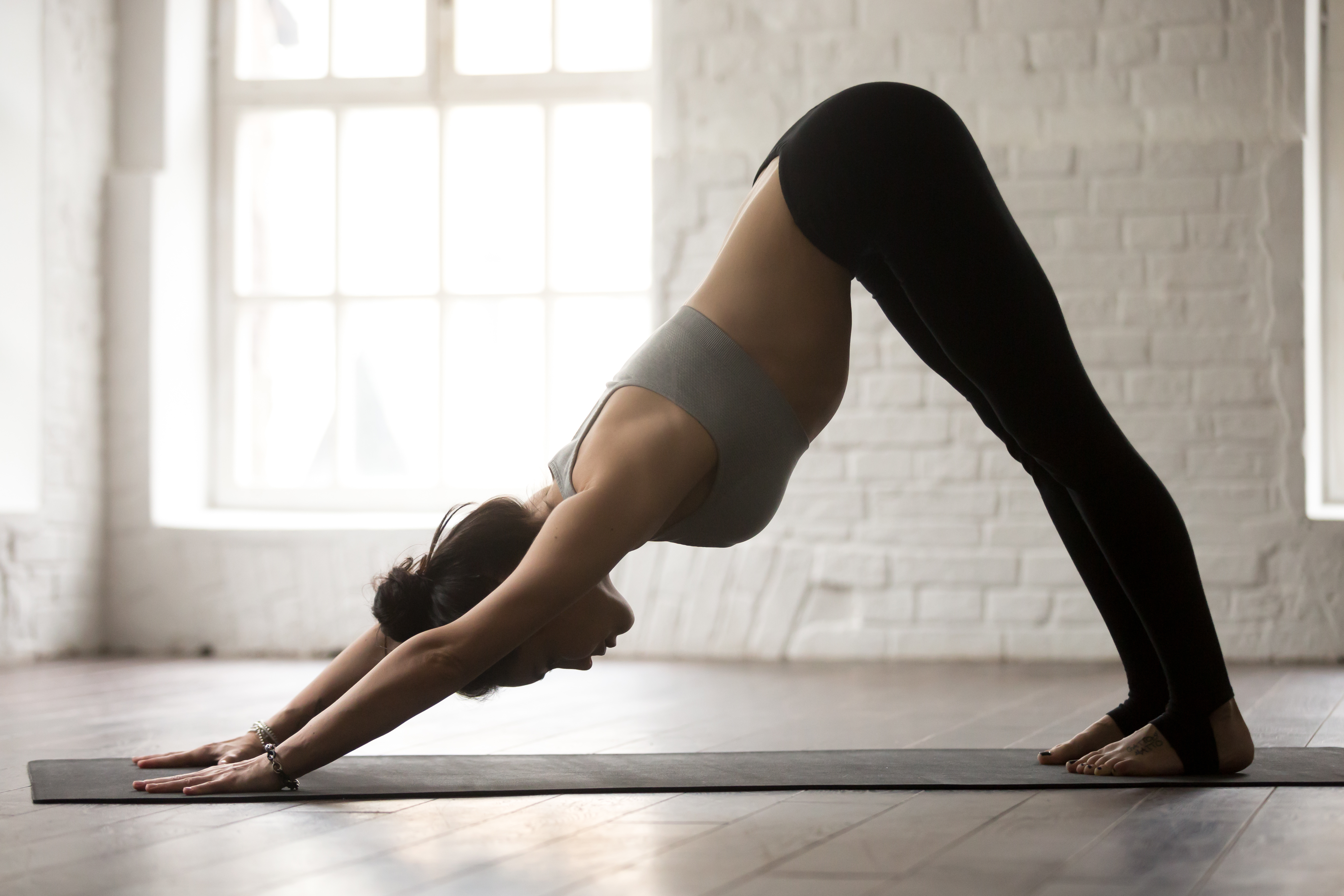Let’s Get Down, Dog

Let’s get down, dog
Downward-Facing Dog, or adho mukha svanasana, is arguably the yoga pose with which everyone is familiar. The A-shaped cornerstone of any Sun Salutation, Down Dog is fundamental to a Powerflow Yoga practice, and rightfully so. Throughout class, you return to this pose over and over again, gradually unfurling your spine back into its natural alignment.
So, what’s the big deal?
Downward Dog seems easy enough, but looks can be deceiving. This pose is actually quite complex: It’s a forward bend, a backward bend, an arm balance and a standing posture. It enlivens your whole body, and helps you to focus your attention. Down Dog is also an inversion, which gets beginners used to the feeling of being upside down.
Since we practice Downward Dog so repetitively, our wrists, elbows and shoulders are at risk for injury due to overuse. This can lead to tendonitis: The tendon connecting a muscle to the bone becomes inflamed, causing pain and limiting motion. Depending on the severity, the tendon may sometimes tear.
Whether you’re a yoga expert or your journey is just beginning, the below tips will help you to mitigate struggle and maximize satisfaction felt in Downward-Facing Dog.
Bend your knees
Let’s be honest: Many of us suffer from tight hamstrings. Stiffness in the backs of your thighs will cause your pelvis to tuck and your lumbar spine to round in Downward-Facing Dog. You may feel excessive tugging in your lower back, which may feel uncomfortable. Further, when your lumbar spine rounds in Downward-Facing Dog, your shoulders will rotate internally. This makes it harder for your upper back and arms to support the weight of your body, placing strain on the biceps tendon and rotator cuff muscles.
When you bend your knees in Downward-Facing Dog, you’re able to elongate your spine more fully. In spinal extension, your arms externally rotate more efficiently and better support your bodyweight. Ideally, Downward-Facing Dog should look like a well-rested puppy waking up from a nap: long and limber. Next time you practice yoga, try maintaining this pose with bent knees as you continue pushing your palms forward and down and your pelvis back and up. Notice what sensations you feel in your spine, and observe how freely your breath flows. If it feels good to straighten your legs, go for it. But remember: Your body is unique, and what’s appropriate for your neighbor may not work for you.
Lift your heels high
When you look around the yoga studio, you’ll see a lot of students practicing Downward-Facing Dog with their heels rested on the ground. While this expression is not wrong, many of us will struggle to maintain spinal extension with our feet low. Again, the pelvis tucks and the spine rounds, and students look like a sad, fearful puppy.
Moreover, the position of your heels depends largely on the structure of your ankle joint and the shape of your Achilles tendon. If you struggle to touch your heels to the ground in other poses like malasana, or Squat Pose, your ankle is likely not suited for feet low in Down Dog.
Lifting your heels high in Downward-Facing Dog brings vibrancy into the legs. This helps to distribute your weight more evenly throughout your body, so that your arms don’t fatigue. When your heels are lifted high, you may notice you’re able to elongate your legs more without rounding your lower back. During your next class, try practicing this pose with your knees bent and heels high. From there, gradually lift your thighs up and press your seat back to lengthen your legs without locking your knees.
Again, think of Downward-Facing Dog as an A-shape: Two halves of your body offering equal support. PFY teacher Carrie Parker-Gastelu recently wrote a beautiful blog post illustrating this concept.
Shoulders: Downward-Facing Dog vs. Warrior 2
When you move your arms, your shoulder blades should shift with them. This is called the glenohumeral rhythm, and it’s an important interaction for the optimal health of your shoulders.
Many yoga teachers cue students to draw their shoulder blades down and back in Downward-Facing Dog. This puts unnecessary stress on your shoulders, since your scapulae should always move with your arms. In this case, when your arms are above your head like in Downward-Facing Dog, Warrior 1 or High Lunge, your shoulder blades should rotate upward and outwardly with your arms. You’ll notice when you push your palms into the ground during Down Dog, your scapulae want to move up your back, not down. Allow this.
For your understanding, the cue to draw your shoulder blades back and down likely evolved from Warrior 2. When the arms are abducted to the side, many of us habitually cram our shoulders up by our ears. This creates unnecessary stress and tension in your neck, and drawing the shoulder blades down and back will help to relax you.
The key take away? Your arms are in different positions in Downward-Facing Dog (flexion) than Warrior 2 (abduction), so the mechanics and muscles used are not the same.
